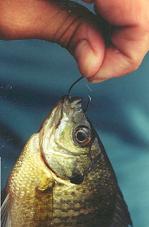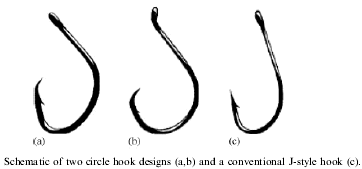 |
|
|
|
 |
Injuries to fish are primarily caused by the hook. There have been numerous studies, with respect to the area of fishery conservation, on hook designs and how they could reduce injuries and mortality. Circle hooks have demonstrated to be the most effective conservation tool, when compared with conventional hooks, to significantly decrease injury and mortality rates without compromising capture efficiency [see paper on Circle Hook Review]. The most obvious difference between circle hooks and conventional hook types is the orientation of the hook point. The point of the circle hook is aligned perpendicular to the shank, whereas the conventional hook (such as J-style hook) is paralell to the shank of the hook. Furthermore, the circle hook is entirely rounded and the shank is shortened. The design of circle hooks should minimize deep hooking in potentially lethal regions and instead hook fish in the edge of the mouth (i.e., upper jaw) or the corner of the mouth. |
|
|
The figure below illustrates two designs of circle hooks and a J-style hook. Studies show that the mortally rates of fish when using circle hooks were consistently lower than when using conventional hooks. The reason for this is largely due to the fact that circle hooks were more frequently hooked in the jaw and not in the vital organs or tissue, as with conventional hooks. |
|
 |
|
1125 Colonel By Drive, Ottawa, ON, K1S 5B6, (613) 520-2600 |
|
